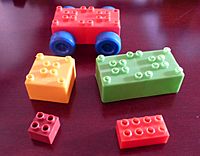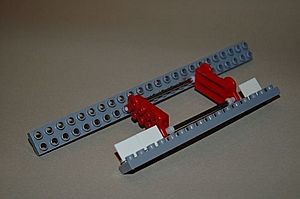Rasti facts for kids
Rasti is a fun building toy made from plastic. It's a bit like Lego, Tente, or Mis Ladrillos. The name "Rasti" comes from the German word rasten, which means "to secure" or "to lock firmly into place." This toy was first made by the Knittax company in Argentina during the 1960s and 1970s. After a break, Rasti toys started being made again in 2007.
How Rasti Blocks Connect
Rasti blocks connect in a special way. You push the pieces together with a bit of force. They lock using strong plastic pins. Unlike some other building toys, this system helps stop the pieces from wearing out. It also makes your models very strong and stable. This means your Rasti creations are super solid!
Why Rasti is So Good
Rasti bricks made in Argentina were known for being very high quality. For example, the axles for wheels were made of shiny chrome steel with plastic tips. Rasti toys became so popular that the word "Rasti" itself became a way to describe things that were strong and long-lasting. People would even say, "It was broken like a Rasti" or "You can build it like a Rasti" to talk about things that could be put together or taken apart.
Rasti toys became very popular in Argentina. They were even sent to other countries like Canada and Germany. Later, the company that made Rasti gave a license to Hering in Brazil. Rasti toys were made there for many years. Even in Europe, Rasti toys kept selling after the year 2000, sometimes called "Rasti-2000," with new colors but the same classic pieces.
Some of the most popular Rasti sets included the Minibox 600, the Multibox 800, and the technical kits 501 and 502. There were also different Rasti Mobil sets (202, 203, 204) and the Motobox 45 and 90. The biggest set was called the "Starbox 1000."
See Also
 In Spanish: Rasti para niños
In Spanish: Rasti para niños





